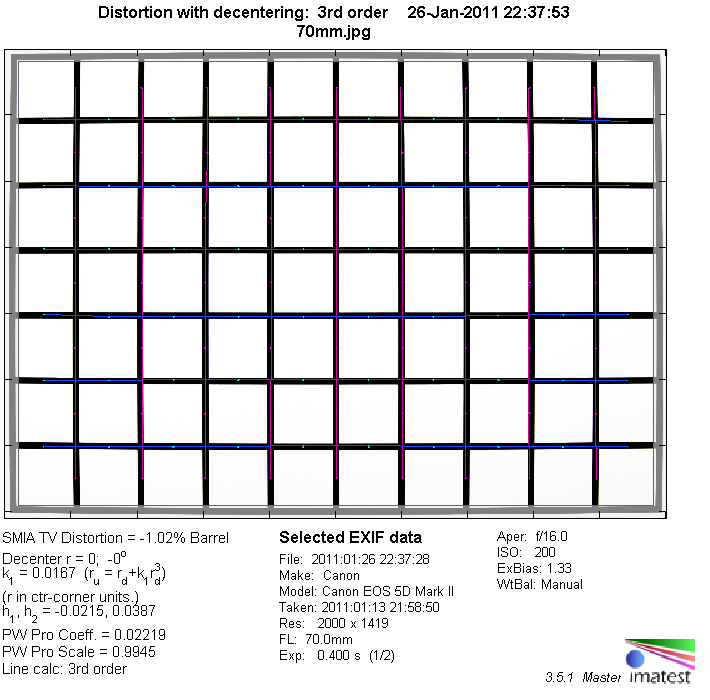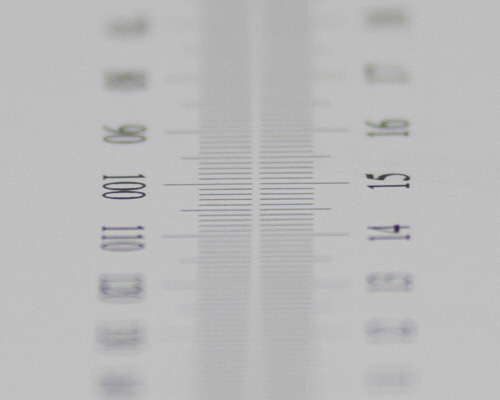|
Tamron AF 70-200mm f/2.8 SP Di LD [IF] macro - Full Format Review / Lab Test - Analysis |
|
Lens Reviews -
Canon EOS (Full Format)
|
|
Page 2 of 3

Distortion
The Tamron SP lens produces a moderate amount of barrel distortion at 70mm and moderate pincushion distortion in the middle to upper zoom range (note: the analysis software reported fairly low distortion at 135mm but visually it looks "moderate" rather than "marginal" here). You may notice that the tested sample reported "188mm" at its 200mm setting. It is not clear whether this is typical for the design or a zoom limiter
which set in too early on this copy/instance of the lens.
|
Move the mouse cursor over the focal length text marks below to observe the respective distortion
|
| 70mm |
135mm |
200mm |
|

|
Vignetting
Vignetting is a critical topic for most lenses when used on full format DSLRs but it's not an
overly significant issue on the Tamron lens. The problem is, of course, still visible at 1.3/1.4EV at max. aperture
and 135mm/200mm but it remains comparatively moderate. It is usually sufficient to stop down to f/4 to solve the
issue and it's technically negligible from f/5.6 onwards.

MTF (resolution)
The Tamron lens delivered a solid performance is our MTF lab. The center performance is generally nothing to
worry about - it is already very good at f/2.8 and excellent in the f/4-f/8 range. The border and corner performance
is also on a very high level at 70mm but there's a more pronounced drop down to about good+ results at 135mm and
200mm.
The amount of field curvature is marginal. While not formally tested it was quite obvious that the performance
decreases towards very close focus distances at the long end of the zoom range. The tested sample showed a very
slight centering defect at 200mm @ f/2.8.
Please note that the MTF results are not directly comparable across the different systems!
Below is a simplified summary of the formal findings. The chart shows line widths per picture height (LW/PH) which can be taken as a measure for sharpness.
If you want to know more about the MTF50 figures you may check out the corresponding Imatest Explanations
Chromatic Aberrations
Lateral CAs are generally very well controlled - the LD elements used in the optical design seem to be pretty effective reducing this aberration.
An average CA width of ~1px or less at the image borders it is usually nothing to worry about in field conditions.

Bokeh
Fast tele zoom lenses should be able to provide a pleasing bokeh (out-of-focus blur) for typical shallow
depth-of-field applications such as portraits. Typical for such lenses it is capable of producing
circular out-of-focus highlights in the center zone but they're deteriorating to a "cat's eye" towards
the borders due to vignetting effects at f/2.8. Stopping down recovers the cat's eye towards a circular shape
in the outer image portions. The inner highlight discs are smoothly rendered. The background and foreground
blur is very smooth whereas the critical focus transition zones is a little more nervous.
All-in-all a very good characteristic here.

These sample portions were taken at ~135mm.
Bokeh Fringing / Longitudinal Chromatic Aberrations (LoCA)
Bokeh fringing is a color fringing effect in the focus transition zone showing a purple halo in front of the focus zone and a green one beyond. The Tamron lens has a rather typical characteristic here with a medium degree of LoCAs at f/2.8. The effect is mostly gone at f/4 and basically negligible at f/5.6. The aspect is more pronounced at 200mm - the sample crops below were taken at 135mm.
|
Move the mouse cursor over the f-stop marks below to observe the respective LoCAs
|
| f/2.8 |
f/4 |
f/5.6 |
|

|
|